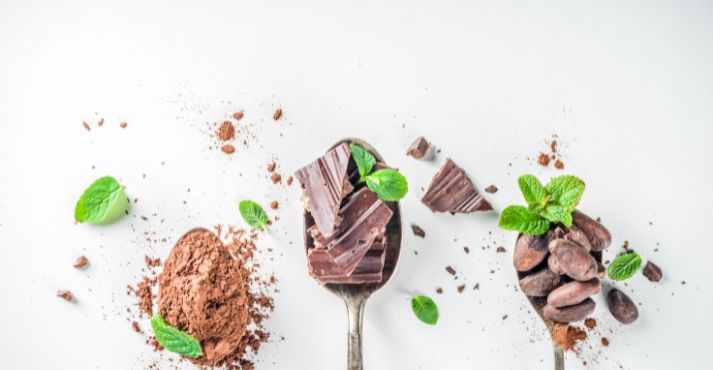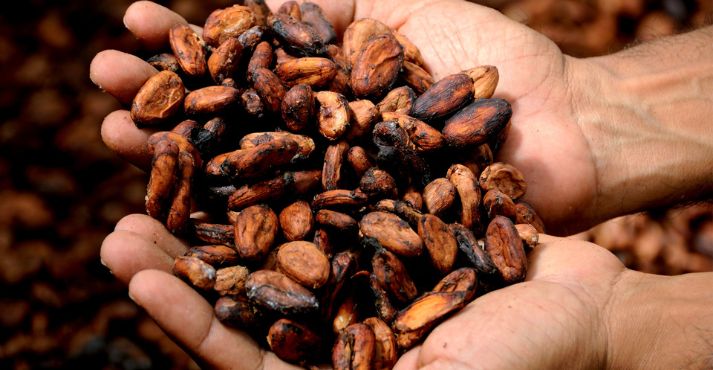Let’s explore the world of cocoa, the key ingredient in everyone’s favorite treat – chocolate. Learn where it comes from, how it’s grown, and the fascinating journey from cocoa beans to the yummy chocolate we all love.
This sweet adventure takes us to what makes cocoa so unique.
Understanding Cocoa
What is Cocoa?
Definition of Cocoa
Cocoa, derived from the seeds of the cacao tree, is a crucial ingredient in chocolate production, contributing to its distinctive flavor and aroma.
Origin of Cocoa
Cocoa finds its roots in the cacao tree, scientifically known as Theobroma cacao. Indigenous to the tropical regions of Central and South America, this tree bears large pods containing cocoa beans, forming the basis for creating cocoa.
Foundational Understanding of Cocoa
To understand cocoa, one must grasp the systematic process involved in its transformation:
Extraction: The process begins with carefully extracting cocoa beans from the cacao pods.
Drying: After extraction, the beans undergo a drying process, which is crucial for their preparation.
Roasting: Roasting enhances the flavor profile, bringing out cocoa’s rich and complex notes.
Grinding: The final step involves grinding the roasted beans, resulting in the creation of cocoa powder.
Cocoa vs. Cacao: Clarifying the Difference
Understanding the Distinction
Cocoa and Cacao: Exploring Nuances
When diving into the world of chocolate and culinary delights, the terms “cocoa” and “cacao” often surface, leading to common misconceptions. It’s essential to clarify the differences between cocoa and cacao.
Cocoa Basics
Origin: Cocoa is derived from roasted and ground cacao beans.
Processing: The beans undergo a process involving roasting, grinding, and, in some cases, additional refinement.
Everyday Use: Cocoa is prevalent in various culinary applications, especially in creating chocolate products and baked goods.
Cacao Explored
Raw State: Cacao refers to the bean in its raw, unprocessed form.
Minimal Processing: Cacao beans are typically cold-pressed to extract butter and create cacao powder.
Health Connotations: Cacao is often associated with a perception of being a more “pure” or less processed bean form.
Clarifying Common Misconceptions
- Raw vs. Roasted: One common misconception is that “cacao” is always raw, while “cocoa” is always roasted. Both terms can refer to raw or roasted forms depending on the food processing methods.
- Nutrient Content: Some may assume that cacao is significantly more nutritious than cocoa due to its raw state. While minimal processing may retain certain nutrients, both cocoa and cacao offer health benefits in moderation.
- Flavor Profiles: The distinction in flavor is subtle, with cocoa often associated with a smoother, milder taste, while cacao may be perceived as more intense and robust.
Exploring Cocoa Varieties: Diverse Cocoa Flavors

Cocoa, the core of chocolate creation, boasts various varieties, each lending unique flavor profiles. Let’s delve into the distinctions among different cocoa types, considering factors like growing regions and flavor intricacies.
1. Criollo Cocoa
Origin: Primarily cultivated in Central and South America, notably associated with Venezuela.
Flavor Profile: Recognized as a premium cocoa, Criollo offers a delicate, nuanced flavor with floral and fruity notes. Its low bitterness and mild acidity make it a prized choice for high-quality chocolate.
2. Forastero Cocoa
Origin: Mainly grown in West Africa, particularly prominent in Ivory Coast.
Flavor Profile: Forastero Cocoa is renowned for its robust and classic chocolate flavor. Its hardiness and disease resistance make it a preferred option for mass-produced chocolate.
3. Trinitario Cocoa
Origin: Originating in Trinidad, Trinitario is a hybrid of Criollo and Forastero varieties.
Flavor Profile: Trinitario cocoa strikes a balance, offering a medley of flavors that combines the delicate nuances of Criollo with the robustness of Forastero. Its versatility makes it suitable for various chocolate creations.
4. Nacional Cocoa
Origin: Predominantly found in Ecuador, Nacional cocoa is gaining recognition for its distinctive flavor characteristics.
Flavor Profile: Nacional cocoa is celebrated for its floral, fruity notes and a distinct lack of bitterness. Its rarity adds to its allure among chocolate connoisseurs.
Processing and Production
Cocoa Harvesting and Fermentation: Processing Cocoa Beans
Harvesting Cocoa: A Delicate Art
Cocoa, the foundation of chocolate, undergoes a meticulous process from cultivation to creation. Understanding the intricacies of cocoa harvesting is essential to appreciate the quality and flavors embedded in each bean.
- Hand Harvesting: Hand harvesting is the preferred method in many cocoa-producing regions. Skilled harvesters carefully cut ripe cocoa pods using machetes or knives from the trees.
- Mechanical Harvesting: Some modern plantations utilize machines to shake the cocoa trees, causing ripe pods to fall. While efficient, this method requires caution to avoid damaging the trees.
Cocoa Fermentation: Transforming Flavor
- Pulp Removal: After harvesting, the cocoa pods are opened to extract the beans covered in a sweet pulp. The beans, still encased in a gummy coating, are then placed in containers for fermentation.
- Fermentation Process: Fermentation is a vital step that lasts several days. The beans, along with the surrounding pulp, undergo natural fermentation. This process is essential for developing the precursor flavors crucial to the final chocolate taste.
- Turning and Aeration: The beans are regularly turned throughout fermentation to ensure an even and complete process. Proper aeration is maintained to encourage microbial activity, which influences flavor development.
Steps in Cocoa Processing: From Bean to Chocolate
1. Harvesting Cocoa Beans
- Hand Harvesting: Skilled workers carefully use machetes or knives to select ripe cocoa pods from trees.
- Mechanical Harvesting: Modern plantations may employ machines to shake trees, causing ripe pods to fall without damaging the trees.
2. Pulp Removal and Fermentation
- Pulp Extraction: Cocoa pods are opened to extract beans covered in sweet pulp.
- Fermentation: Beans, along with the surrounding pulp, undergo natural fermentation, a crucial step in developing precursor flavors.
3. Drying the Fermented Beans
- Sun Drying: Fermented beans are spread out in the sun, allowing them to dry naturally.
- Mechanical Drying: Some facilities use mechanical dryers to control the drying process.
4. Roasting the Dried Beans
- Roasting: Dried beans are roasted to produce rich flavors and reduce moisture content.
5. Grinding and Conching
- Grinding: Roasted beans are finely ground to produce cocoa mass or cocoa liquor.
- Conching: The cocoa mass undergoes conching, heating, and grinding to refine texture and flavor further.
6. Cocoa Butter Extraction
- Pressing: Cocoa mass is pressed to extract cocoa butter, leaving behind cocoa solids.
- Cocoa Butter: Extracted cocoa butter is a crucial ingredient in chocolate production.
7. Blending and Refining
- Blending: Cocoa solids, cocoa butter, sugar, and milk (if making milk chocolate) are blended to form chocolate liquor.
- Refining: The chocolate liquor undergoes refining to achieve a smooth texture.
8. Tempering and Molding
- Tempering: The chocolate is tempered to ensure a glossy finish and proper crystalline structure.
- Molding: Tempered chocolate is poured into molds and cooled to create the final chocolate products.
9. Packaging and Distribution
- Packaging: The finished chocolates are packaged for distribution and sale, ensuring quality and freshness.
- Distribution: Packaged chocolates are distributed to retailers or directly to consumers, ready to be enjoyed.
Culinary Uses of Cocoa
Culinary Applications
Cocoa in Cooking: Infusing Richness into Savory Delights
- Cocoa Rubs: Fusing cocoa with spices creates delectable rubs for meats, adding depth and complexity to savory dishes.
- Mole Sauces: In Mexican cuisine, cocoa takes center stage in mole sauces, contributing a unique richness to poultry and meats.
- Cocoa Nib Garnish: Sprinkling cocoa nibs over salads or savory dishes offers a delightful crunch and a hint of chocolate bitterness.
Baking with Cocoa: Crafting Sweet Masterpieces
- Classic Chocolate Cake: Cocoa is a star ingredient in the classic chocolate cake, lending its rich flavor to this beloved dessert.
- Decadent Brownies: The fudgy texture and intense chocolate flavor of brownies owe much to including cocoa.
- Chocolate Truffles: Cocoa coats luxurious chocolate truffles, creating a velvety finish.
Culinary Delicacies with Cocoa: A Symphony of Flavors
- Cocoa-Infused Beverages: From hot cocoa to chocolate-infused cocktails, cocoa elevates beverage experiences.
- Cocoa-Enhanced Sauces: Adding cocoa to dessert sauces, ganaches, or barbecue glazes brings a unique and enticing twist to culinary creations.
- Chocolate-Covered Treats: Cocoa is the coating for various treats, from strawberries to nuts, enhancing the overall indulgence.
Health Benefits of Consuming Cocoa: Nutrient-Rich Delight
1. Rich in Antioxidants
- Flavonoids: Cocoa is abundant in flavonoids, potent antioxidants known for their potential to combat oxidative stress and inflammation.
- Polyphenols: These compounds in cocoa have been linked to various health benefits, including heart health and improved cognitive function.
2. Heart Health
- Blood Pressure Regulation: Studies suggest that regular cocoa consumption may regulate blood pressure and promote cardiovascular health.
- Improved Cholesterol Levels: Cocoa has shown promise in positively influencing cholesterol levels, particularly by increasing “good” HDL cholesterol.
3. Mood Enhancement
- Endorphin Release: Cocoa contains compounds that may trigger the release of endorphins, the “feel-good” hormones, contributing to an improved mood.
- Serotonin Levels: Some studies suggest that cocoa positively impacts serotonin levels, potentially benefiting mental well-being.
4. Cognitive Function
- Brain Blood Flow: Cocoa consumption has been associated with increased blood flow to the brain, potentially supporting cognitive function.
- Neuroprotective Properties: The antioxidants in cocoa may have neuroprotective effects, offering potential benefits for brain health.
5. Nutrient-Rich Profile
- Minerals: Cocoa is a source of essential minerals such as magnesium, copper, and iron.
- Dietary Fiber: Dietary fiber in cocoa contributes to digestive health and overall well-being.
Conclusion
In conclusion, cocoa is a versatile culinary gem, enriching sweet and savory creations. Beyond the kitchen, it weaves into cultural traditions, bringing warmth and sweetness to diverse celebrations.
Economically, cocoa plays a pivotal role in sustaining livelihoods and communities globally.
This humble bean, transformed into chocolate, is not just an ingredient but a cultural symbol and economic force, reflecting tradition, innovation, and the simple joy it brings our lives.














